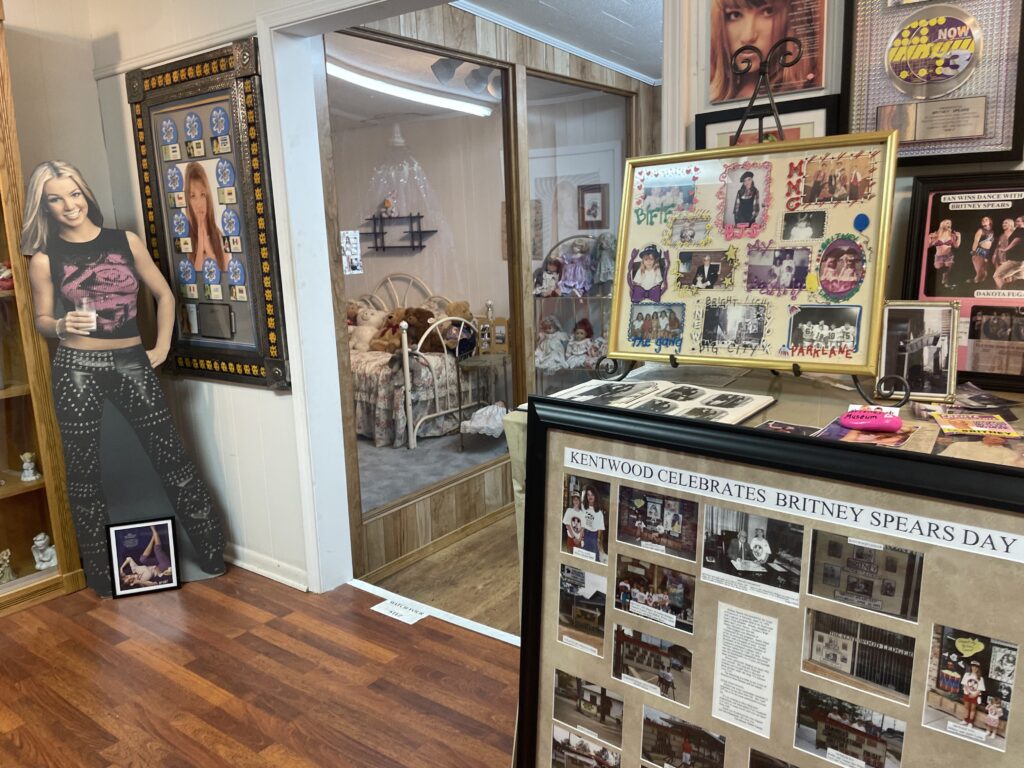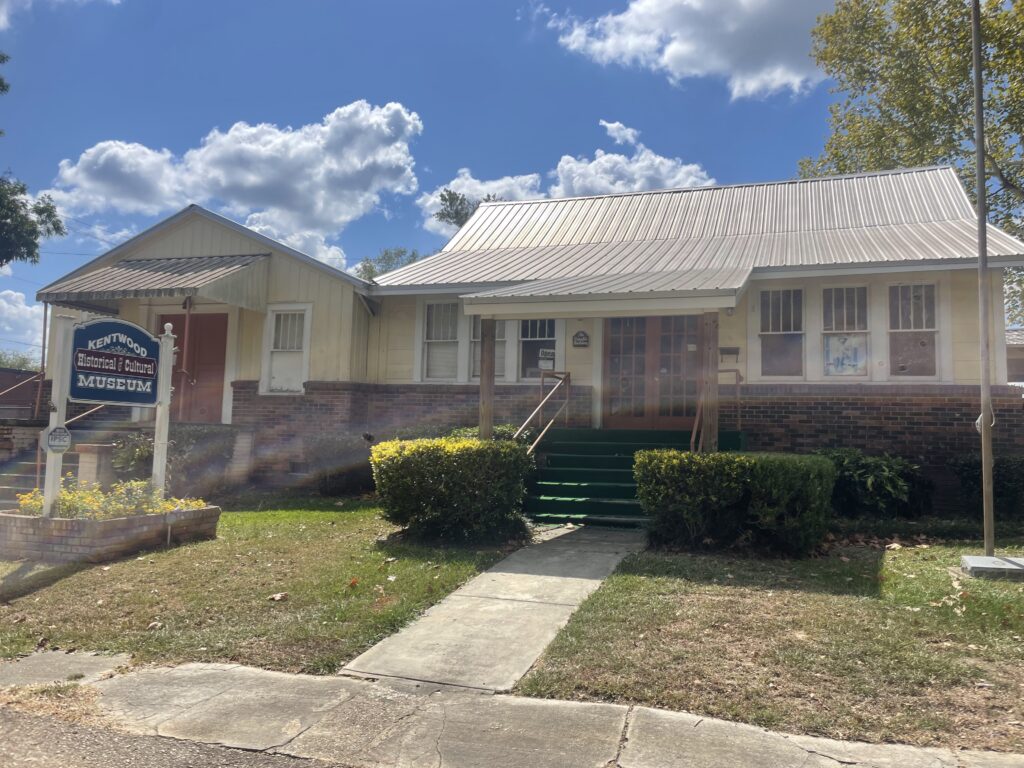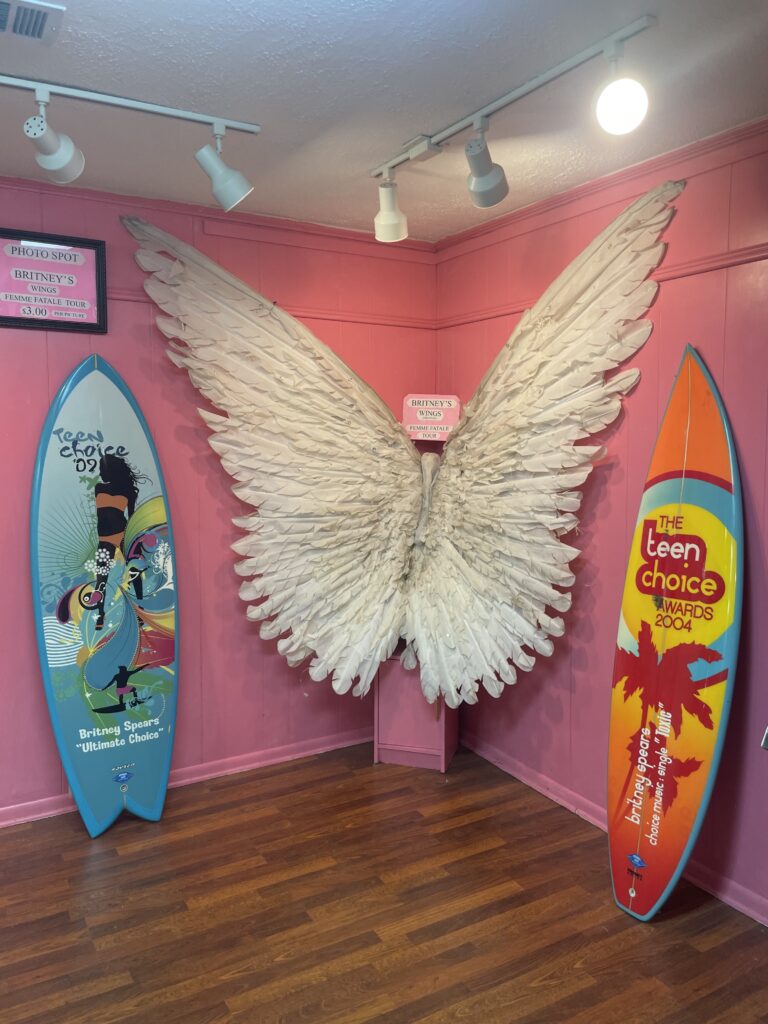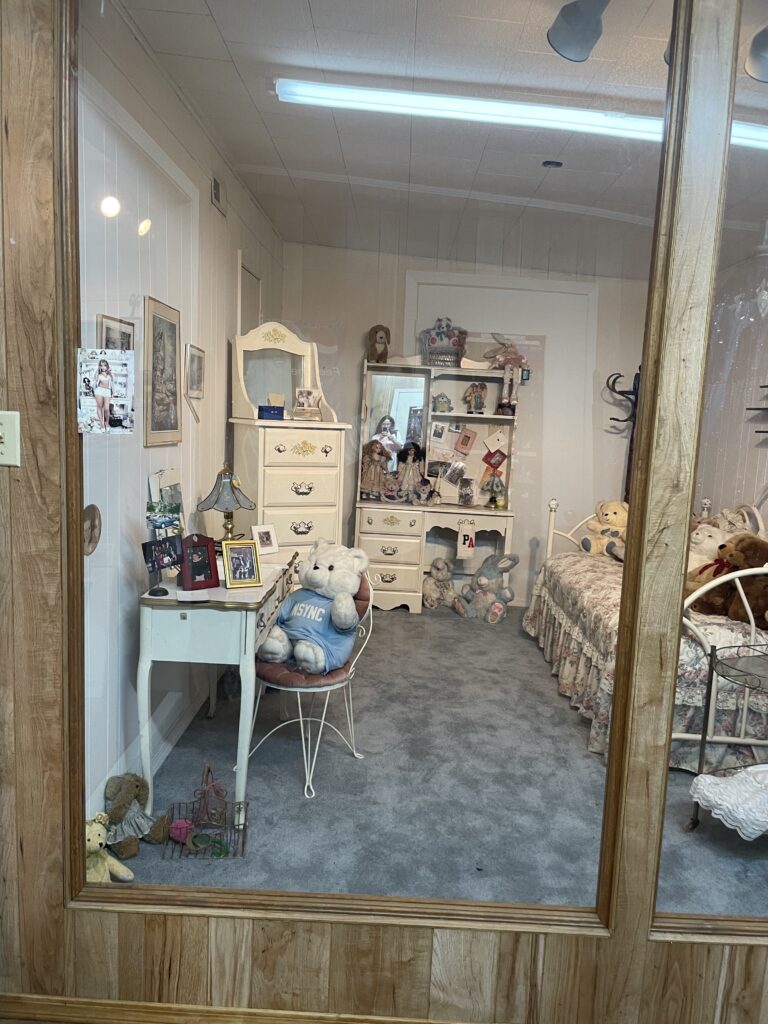
Photograph by Emmeline Clein.
 Besides Britney, bottled water is Kentwood’s biggest export. Across most of Louisiana, this town is more famous for the water than the woman. “Why are you going to the water bottle town?” the man sitting next to me at the bar asks. I’m in New Orleans, on Carondelet Street.
Besides Britney, bottled water is Kentwood’s biggest export. Across most of Louisiana, this town is more famous for the water than the woman. “Why are you going to the water bottle town?” the man sitting next to me at the bar asks. I’m in New Orleans, on Carondelet Street.
I’m eating at an oyster counter near my grandfather’s former office. Not his favorite, the Black Pearl, where he used to eat a dozen daily on his lunch breaks, grading each one on a scale of 1–10 in his notebook. He died at the start of spring this year, smack in the middle of Carnival, the ambulance stuck in parade traffic for an hour. When I tell the man next to me I’m going to Britney Spears’s hometown to see her house, he says he saw her perform before she became Britney Spears, when she was still Britney from Kentwood, at a concert called Louisiana Jukebox. She was there with her mother, answering audience questions after the show. A childhood friend of my mother’s was there, too, and had incidentally emailed me about it the night before. It was disturbing, she remembered; Britney was so young, but her “song was so sexual, and in person, she looked like the girl next door who every man wants to devirginize.”
The next morning, the drive through St. John the Baptist Parish is mostly swamp. Highways on thick stilts through the cypress glens; the long, low bridge over Lake Pontchartrain. Two men fishing, smoking, laughing. Once you cross into Tangipahoa Parish, you’re mostly on dry land, which means Bible billboards and fast-food spots.
On the off-ramp into town, I see the water tower emblazoned with the Kentwood logo, familiar from plastic bottles. I drive down the town’s main street, past buildings with drooping awnings and wilting, cantilevered roofs, an abandoned white brick structure that reads “Kentwood Glass” in faded, sky-blue letters and a boarded-up bar called Sip Some Daiquiris. I stop at a red light next to This & That Pawn Shop, across from a café called The Cafe, which does appear to be an accurate moniker. It’s the only one in town. I knew Kentwood would be small—the cottage industry of Britney documentaries all describe it as a sleepy town, and a denizen of a Britney message board I’ve browsed periodically for years returned from their own trip here only to post that the area had a “southern gothic vibe” and note, appalled, that “there is NO WALMART, MCDONALDS, or HOSPITALS.” A visiting reporter once observed that Britney was forced to “travel an hour to shop at her nearest Abercrombie and Fitch.” I pull into a spot at the Sonic for sustenance and Diet Coke. Britney was repeatedly followed here and photographed and the resulting images posted to gossip sites. I remember scrolling the zoomed-in shots of Britney and her sister fingering fries, avoiding the camera’s eye. Britney had one hand on the wheel, the other headed for her mouth. Thanksgiving 2010.
Remember Britney begging us for a sign? She asked us to hit her in the same song, and we might have taken her too literally. I wonder who she was serenading: God, an ex, or us, her future fans, styling ourselves saviors? When directing a Rolling Stone reporter to their home in Kentwood in 1999, Lynne Spears, Britney’s mom, told him to “turn right when you pass the Burning Bush.” A neighbor had lit a hedge on fire in their yard. At the time, Britney was sleeping in her parents’ bed because an ardent fan had recently climbed through her bedroom window. After her album went platinum, Britney went to the bank and took out $10,000 in $100 bills. At Christmastime, she drove down the town’s main drag, rolling the window down and handing out hundreds to everyone she saw. Messy messiah or prodigal daughter? Trading home’s plastic water bottles for the pop of dom in a dark club, coming home to perform financial miracles.
Burning bushes, Britney-flooded tabloids, baptism by Blackout album: all these signs can feel a bit heavy-handed here in the bayou, where I drive by a house on stilts sitting smack in the middle of a lake, its roof painted yellow and emblazoned with the words JESUS HEALS THE HEARTBROKEN in blood-red letters. It’s hard to hold on to rationality on an average day, and this is the first time I’ve been to Louisiana for anything other than a funeral or a wedding in months. Other messages I’ve received on this journey: JESUS HAS THE ANSWER, BAD BOYS MOW, TRUST YOUR GUT, FAUX PAS REPAIR HERE, APOCALYPSE WEAPONS AVAILABLE, IN JOY YOURSELF. I will—I’m on my way to a shrine.
***

Photograph by Emmeline Clein.
On a residential street a few blocks from The Cafe, the blinds are drawn on a one-story red-brick and yellow-wood home, but Britney seduces from the window, staring wide-eyed from a poster pressed against the glass. A sign on the door to the Kentwood Historical and Cultural Museum tells me to ring the bell, so I do. (There is some confusion because Britney is the centerpiece of what is officially termed the Kentwood Historical and Cultural Museum. Hence one irate Google review: “I expected an exhibition of spears and arrowheads from early indigenous tribes. Imagine my surprise to travel 4000 kms and discover this museum is about a female popular music artist!!! Oh well … i bought a lock of blonde hair instead.”) A brunette woman in a hot-pink polo shirt answers the door and asks me if I’m here to see Britney.
The tour takes about twenty minutes and begins with Britney’s wings. The tour guide, Britney historian, and museum proprietor is named Fay, and she tells me these are the wings Britney wore onstage during the Femme Fatale tour in 2011, donated to the museum by her parents. They look like they must be at least six feet tall, a white feathered mass mounted on the bubblegum-pink walls, pocked with cubic zirconia that catches the light. Britney might be both femme fatale and angel, but traces of her literal body remain here on her wings. They’ve gone beige at the bridge, where her back once sweat under spotlights night after night. The next four rooms are filled with Britney’s belongings, Britney photos and fan-made illustrations, tour equipment, framed magazine covers and platinum record awards and family portraits, limited edition Britney soda cans and Barbie dolls, life-size paperboard Britneys, local newspaper clippings, a sign that once stood on the edge of town announcing Kentwood as the Home of Britney Spears, and congratulatory notes from Kentwood officials. The ephemera seems infinite. As she recites the litany of Britney lore she’s been retelling for fourteen years, Fay’s voice bends toward boredom, but she swerves into tenderness at certain anecdotes. She tells stories of fans who arrive at her door like pilgrims, armed with indulgences, and present her with their taped-together poster boards and glitter-drenched collages, love-lined dioramas.

Photograph by Emmeline Clein.
Fay tells me that this museum is a collaboration between Britney’s family and her fans and is filled with donations from her parents and the devotees who visit, bearing gifts, as well as the ones who can’t make it to Louisiana and mail in their offerings. The museum’s centerpiece is a room within a room, a glass wall protecting it from the rest of the house, from our sweaty fingertips and heady breath. It is a reconstruction of Britney’s childhood bedroom, the one immortalized in a 1999 David LaChapelle cover shoot for Rolling Stone. It’s not a replica but a reconstruction, using Britney’s original belongings, down to the uprooted carpeting from the room she spent her childhood in—all donated by her parents while she toured, growing up on the road. One of the photos from the shoot is taped to the glass so her fans can encounter the uncanniness of the re-creation. I stare in at an angle, standing next to a life-size cutout of the starlet with a milk mustache, posing for a Got Milk? ad.
In the image taped to the glass, teenage Britney leans against a white desk, appearing ambushed by baby dolls. They line the wall at her feet, sit above the desk hutch over her head, recline next to her cocked hip. They wear Victorian dresses, beady black eyes aglow in the flash. Our adolescent idol is much less covered up, in a white bra and boy shorts underwear, a shrunken cardigan open over her midriff, bright white high heels on blue-gray carpet. The reporter referenced her “honeyed thighs” in the first sentence of this profile. She was seventeen, straddling adolescence, and dressed in a schoolgirl uniform skirt. Her parents donated every item of furniture, stuffed animal, doll, and desk tchotchke in the photograph to the museum.
In her 2023 memoir The Woman in Me, Britney writes that those dolls in the photograph, now housed in the museum, were her “prized possessions” as a girl. She recalls coming home from a tour to find her baby dolls abducted: “When I saw the empty shelves, I felt an overwhelming sadness.” She doesn’t mention the museum in her book, and I wonder if she knows that in this former funeral home turned mausoleum of another sort, her looted childhood lives on.
Jamie, Spears’s father, isn’t the “meanie” he’s made out to be, Fay says, and she’s known the Spears family for years, used to make the bows Britney wore in her hair. In a 2008 MTV documentary I rewatched last night, filmed during the early days of Britney’s conservatorship, Jamie stands in his kitchen in a white tank top, cooking his daughter breakfast. “Making my baby some cheese grits, Southern girl’s breakfast of champions,” he says, stirring. In the next scene, he’s talking with two other middle-aged men, and everyone agrees that no one can speak to Britney without going through one of them first. Famously—now infamously—Jamie had, just before this documentary’s filming, forced Britney into the conservatorship that was overturned in 2021. He took her belongings out of her bedroom, much like he ripped Britney herself out of girlhood and into the hot spotlight, where she was forced to grow up fast under our gazes, and then snatched her off the stage and shoved her into a hospital room lit fluorescent, locking her in a conservatorship for over a decade. Fay’s insistence on his innocence, his good intentions, hang in the stagnant air between us (also the AC is broken). Britney’s stuffed animals sit in a neat row. A snow-white bear wears a baby blue NSYNC T-shirt. The porcelain dolls glare at me. Fay comments that she needs to clean—there’s a dead bug on the rug.

Photograph by Emmeline Clein.
Turn left out of Britney’s bedroom, and atop a display case, a yearbook is open to a full-page portrait of Britney and a boy, respectively voted most beautiful and most handsome in their high school class. Britney’s name is spelled wrong—two ts. Near one of her signed posters, there are two official-looking documents, decked out with government seals. One is a Tangipahoa Parish Council Proclamation declaring July 10, 1999, Britney Spears Day. The other is a fake-seeming military document deeming Britney a patriotic participant in something called Operation Southern Watch—which, I learn later when a well-informed friend reads a draft of this and directs me to Wikipedia, was an “an air-centric military operation conducted by the United States Department of Defense from Summer 1992 to Spring 2003” over southern Iraq. The nature of Britney’s participation remains unclear.
In the next room, which is painted almost the same shade of fuchsia as Fay’s shirt, we come to the contributions from fans. A full quarter of the room is taken up by a replica of the concert stage from Britney’s HBO special, handmade by a fan named Randy, down to the light fixtures and spinning central platform, with a Britney doll standing center stage. Fay turns out the overhead lights, and the stage glows red; plasticine Britney smiles, haloed by tiny bulbs. A collection of Britney calendars are taped to a room divider, which stands next to a wall covered in concert merch, laminated VIP tickets, and a collage of photos of Britney onstage. Fay tells me a young fan sent all this in and that his mother called after he wouldn’t tell Fay why he was sending in his prized possessions to tell her that her son was dying of an inoperable brain tumor.
In this mausoleum of Britney’s lost innocence, there is also the indisputable detritus of love. These cramped rooms are overwhelmingly, disorientingly tender, held together with tape and yellowed concert tickets and simple, true care. Every time I try to fly I fall / Without my wings I feel so small, Britney sings. But her wings are here, and they’re huge. They fit her perfectly.
Almost tearful and trying to be surreptitious about it, I crouch to the ground to investigate a large framed poster, which is covered in disposable camera photos of Kentwood restaurants’ marquee displays from the weeks leading up to Britney’s departure for Los Angeles to become a Mouseketeer at age eleven. At Kentwood Donut Shop, which must have had only two T’s on hand: CONGRA ULATIONS BRITNEY. The then-manager of Sonic stands next to their sign, which reads BRITNEY SONIC’S FAVORITE MOUSEKETEER. At Buddy’s Seafood: BRITNEY SPEARS DISNEY OR BUST. Next to this is a craft project Britney herself made, a framed collage of her friends and family, photos with captions drawn in loopy, meticulous marker cursive. BFF.
Leaving, I drive ten minutes out of town and stop outside the gated estate Britney has owned since 1999, the year of Louisiana Jukebox, “… Baby One More Time,” and her Rolling Stone debut, posed like one of her baby dolls in her childhood bedroom. In that 2008 documentary, she’s filmed in the studio recording songs for the album Blackout. Singing into the mic, she wears a beaded choker with her two sons’ names on either side of a pendant and accuses us: You want a piece of me. There’s a moment during this recording session when she looks directly into the camera and wonders why she didn’t move back to Louisiana after she had children. In my idling rental car, wondering whether anyone is home in that big McMansion on the hill, I hope she does some day and finds the word carved into the wrought iron of those gates, the name she gave this place: Serenity.
Emmeline Clein‘s debut collection of essays, Dead Weight, is forthcoming from Knopf in February. Her chapbook Toxic was published by Choo Choo Press in 2022.
from The Paris Review https://ift.tt/YSAekLw
Comments
Post a Comment